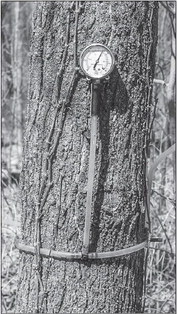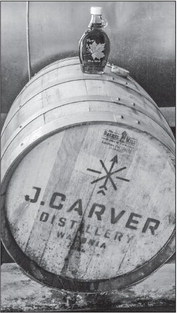A NEW BALL GAME


Time honored maple syrup biz meets modern tech
Dave Loucks is about as Wisconsin as it gets. For decades, Loucks and his wife Gerri have been immersed in two of Wisconsin’s most time honored trades — dairy farming and maple syrup.
Loucks has spent much of his life working in Wisconsin’s dairy industry on the family farm in Abbotsford.
In 1973, Loucks earned a degree in business, but there was little in the way of work. That changed when his father hurt his back, so Dave went to work on the family farm and slowly built it up, purchasing nearby land and cows until he had over 400 dairy cows.
“I was a dairy farmer for 35 years,” Loucks says proudly. “I loved it for 34 years . . that last year was tough. That last year, most days I didn’t even want to get up and see a cow.”
Loucks sold the cows over a decade ago, but kept the woods, and his connection to it runs deep. These days, he keeps busy making maple syrup and also running a firewood business on his property, which is located roughly five miles from Abbotsford on the north side of Hwy. 29.
You know you’re near his property when you see an old tank bearing the website maplesyrupwisconsin.com.
It can be cold and tough work, especially in the winter, but Loucks is in his element when he’s in the woods. He’ll check to see if fallen branches, debris or flooding has knocked anything out of place on his double-pipe line system that stradles the forest floor and makes his maple syrup business possible.
“I could never do a desk job,” he says. “I think I would have hated that, so I’m fortunate that my dad got hurt and I was able to come back. There’s nowhere else I’d rather be than here.”
Loucks may no longer be working those 80 hour weeks in the dairy industry, but he still spends a great lot of time on his maple syrup.
“I’m ‘retired’ now,” he says with a smile and a laugh. “So instead of putting in 75 to 80 hours a week, I’m only doing 35 hours a week.”
Dave gets help from his children, Josh and Dawn, and grandchildren Jack and Lily. Dave’s brother Brian helps with road side sales, and his brother Russell set up the computer sales program. But no discussion would be complete without mentioning Gerri’s contributions.
“Gerri does a lot of the order taking on the internet and the packaging. Back in the old days, she came out and helped gather the sap. She’s been in the business almost as long as I have.”
The changes he has seen in the maple syrup industry still astound him when he recalls the work it took to get the syrup in his younger days. Dave can remember struggling through mounds of mud, doing his best not to drop his pails and contaminate the sap.
“I remember coming out here with my grandpa and cooking syrup. Back then, it was pails; there were no bags. The bags have only been out for 20 to 25 years. So back then it was pails, a lot of them were galvanized pails,” Dave recalls.
“We cooked on an open pan, and there’s several places in the woods where we used to set up the evaporator. Now, anybody over 300 to 400 trees has usually gone to the pipeline system.”
He’s long since abandoned hammering tappers into trees and cooking sap over an open fire. These days, when Dave talks about his maple syrup operation, he uses words like “reverse osmosis,” “pressure gauges” and “double-line systems.”
“The amount of technology change in the last 15 years has been unbelievable. It really hadn’t changed much up until about 40 years ago, and now, all of a sudden, it’s a whole different ball game.”
Around 30 years ago, Loucks adopted the double pipeline system. Now he can tap up to three to four thousand trees. A quick, cursory glance at his operation shows lines of plastic piping zig-zagging through the woods that surround the former dairy farm.
He likens his double-line system to that of a feather.
“Your main part of the feather is coming downhill, and your lateral lines that approach from the trees come in at an angle, and everything is sloping downhill,” he explains. “A two percent slope is good . . . and they have found in the last few years that if you have a lot of slope, like five percent, it will actually put a natural suction on the tree, and the gravity will make its own vacuum at the tree.”
The pipes carry gallons of water-infused sap into big drums called receivers every day during the peak of the season. Two main lines bring the sap from the top of the hill, and a vacuum line connects to Loucks’ receiver and pumps the sap to a holding tank. The sap is then brought to the main hub, which holds the reverse osmosis and evaporator.
Loucks takes advantage of the features of his property, placing his receivers in natural depressions, slopes and valleys around the woods. Pressure gauges are placed at various intervals to make sure there’s enough suction to allow for the steady flow of sap.
If you listen quietly, you can even hear the sound of sap being carried through each pipe, the noise thrumming through the woods like the steady beat of a heart.
Dave has fine-tuned the process over many years to achieve maximum results.
“The first two times we set lines up, we were learning,” he said. “It’s pretty close to where it should be now.”
The trade has certainly come a long way, with innovations in technology modernizing each step in the process, turning the sap into the delicious, golden brown syrup craved by so many faster than ever before.
Which is good, since demand for the syrup continues to remain high. The Loucks are hoping it continues to stay that way.
“I do worry about over-producing. Up to now, we still have enough demand to meet production. What will happen in the next 20 years? I don’t know,” Dave says with a shrug. “We may out-produce the market, or maybe demand will keep going up. But it’s a natural product, and I think people are kinda getting away from the dextrose-based, processed stuff.”
Thankfully, Loucks hasn’t yet had a problem selling his syrup, and even though he enjoys making the syrup, he has always approached it as a job.
“It was always more of a business, because living on the highway here, we’ve sold maple syrup as long as I can remember. We would sell all that we could make. We had a real good business — all the Minneapolis and Green Bay traffic has treated us excellent over the years.”
That’s another thing that’s changed, says Dave. His customers have gone from driving down a highway to get the syrup to surfing the internet to find him.
“Up until the internet, everything was pretty much roadside traffic, up until 10 years ago. We have an excellent location, we have a good product, and a lot of repeat customers,” he said. “The summer time business was unbelievable, and they’d stop year after year, so we have a good customer base.”
Roadside traffic now constitutes just 10 percent of his sales. Outside of internet transactions, Loucks has a distributor in Milwaukee that sells his syrup to high end restaurants.
“He sells probably 20 to 30 percent of it, and then we’ve got a website. So we got old customers and new customers. Every day we’re shipping out a package.”
The Loucks ship their syrup all over the U.S., including Alaska and Hawaii. They avoid overseas sales due to the exorbitant cost of international shipping. Dave says he’s noticed that more and more people are getting involved in the business, since technology makes everything easier.
“So far, we’ve seen an increase in producers that have gotten into the business in the last 10 years because of the technology. It makes the work a lot faster. You can set these lines up when the weather is fair, and once it’s set up you just hook your line up to the tree.”
When everything is ready, and the season begins, and the temps start to climb in the spring, a temperature sensor starts up the pumps and everything begins to flow.
That’s not to say the weather isn’t still a factor, especially for those who still use the tappers, pails and open pan fires.
The weather can be your greatest friend or biggest foe, with so much of the syrup dependent on the freeze-thaw cycle of spring. But that’s not the case for Loucks and his operation.
“With the bags and the pails, you have your up years and your down years, and that’s because of the weather. Since we went to the high vacuum, we are able to produce almost the exact same amount of sap every single year.”
But Mother Nature still has her say.
“We are still dependent on the weather. We still need frost at night and a nice 40 to 45 degrees during the day.”
Passion and knowledge are also still very much needed. Even after 50 years, Loucks says he still loves what he does.
“You got to love the outdoors. That’s it. You gotta love the outdoors and enjoy being outside. I do, and it’s a good income.”

INNOVATIONS -Above left, a pressure gauge helps maintain a steady flow of sap from Loucks’ trees during the maple syrup season. Loucks has added numerous innovations to his maple syrup operation over years. He also offers new products, like syrup that’s aged in oak bourbon barrels that gives his syrup a unique flavor and aroma that carries just a hint of bourbon.

